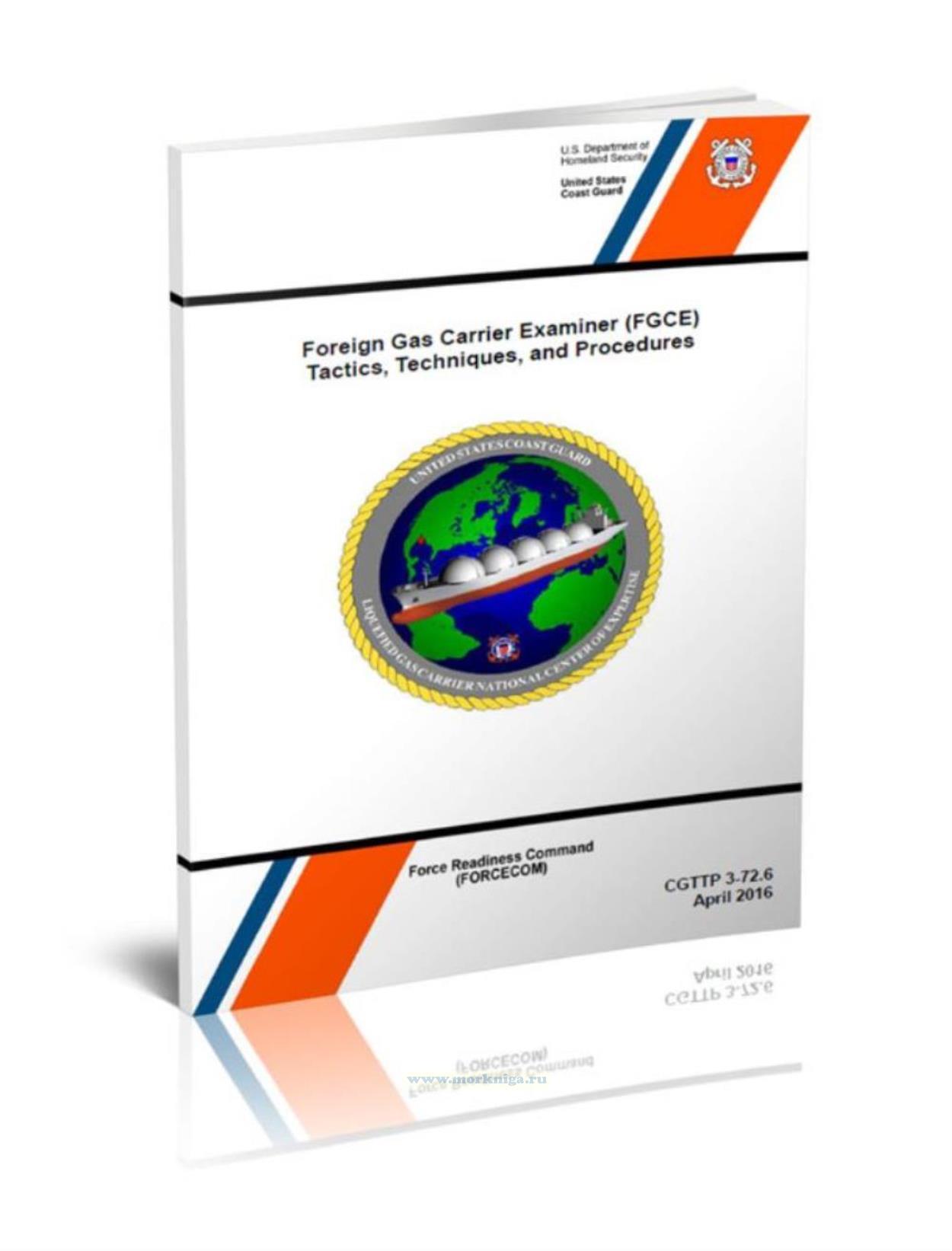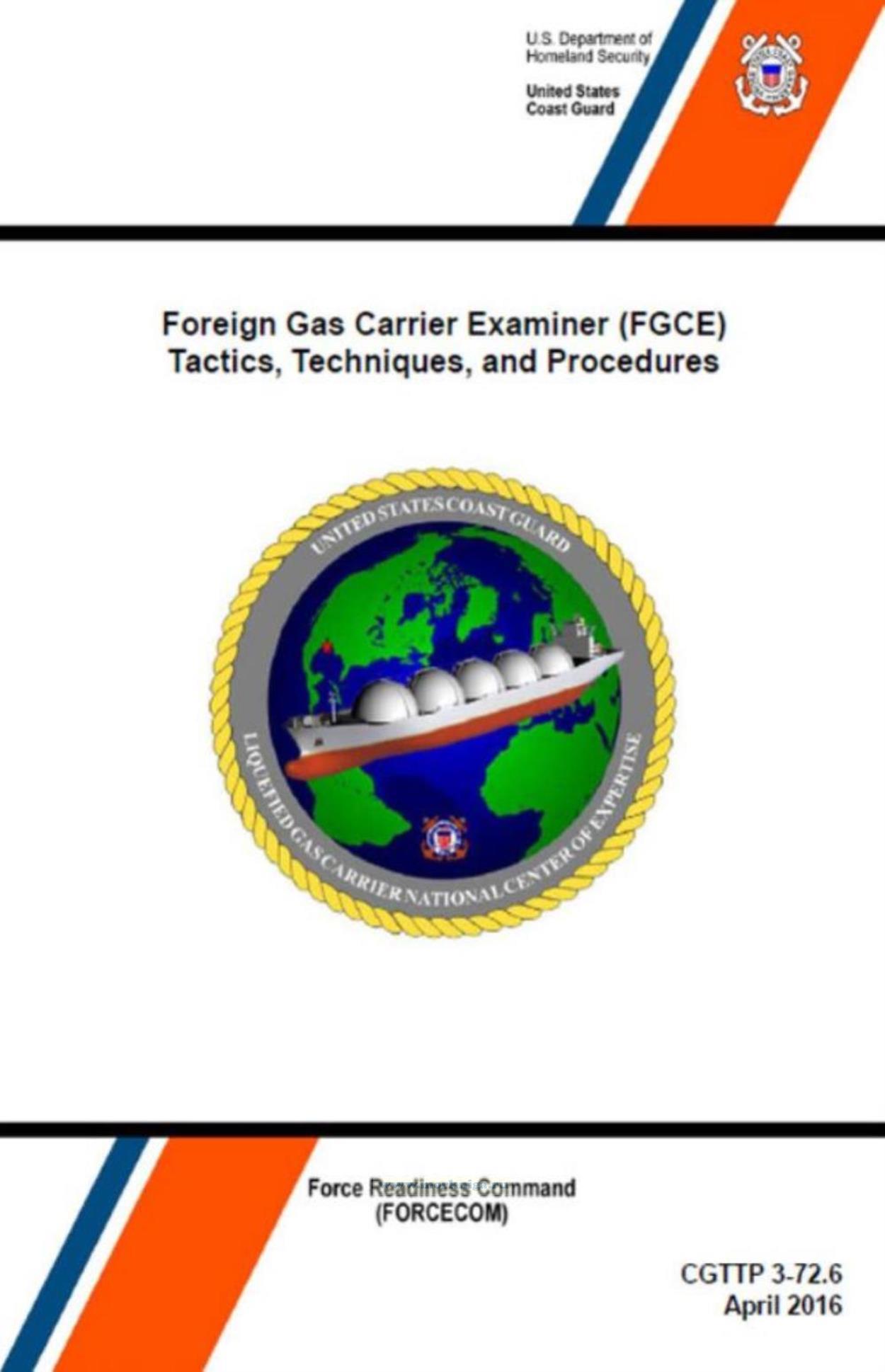Foreign Gas Carrier Examiner (FGCE) Tactics, Techniques, and Procedures/–Ґ–∞–Ї—В–Є–Ї–∞, –Љ–µ—В–Њ–і—Л –Є –њ—А–Њ—Ж–µ–і—Г—А—Л –Є–љ—Б–њ–µ–Ї—В–Њ—А–∞ –Є–љ–Њ—Б—В—А–∞–љ–љ—Л—Е –≥–∞–Ј–Њ–≤–Њ–Ј–Њ–≤ (FGCE)
–Ъ–љ–Є–≥–∞ –љ–∞ –∞–љ–≥–ї–Є–є—Б–Ї–Њ–Љ —П–Ј—Л–Ї–µ
Purpose of this publication: To provide port state control officers (PSCOs) and apprentice marine inspectors (AMIs) with Coast Guard tactics, techniques, and procedures (CGTTP) on Certificate of Compliance (COC) examinations of foreign-flagged liquefied gas carriers.
Contents
Table of Contents
Table of Figures
Table of Tables
Chapter 1: Introduction
Section A: Introduction
Section B: Notes, Cautions, and Warnings
Chapter 2: Pre-Exam (PE) Preparation
Section A: Certificate of Compliance (COC) CG-3585
Section B: Safety Meeting
Section C: Gas Code Applicability
Section D: Gas Carrier (Ship) Types/Containment Systems
Chapter 3: Certificates and Documents (CD) Examination
Section A: International Pollution Prevention Certificate for the Carriage of Noxious Liquid Substances in Bulk (IPP NLS)
Section B: COF - International Code for the Construction and Equipment of Ships Carrying Liquefied Gases in Bulk (IGC Code)
Section C: COF вАУ International Code for the Construction and Equipment of Ships Carrying Liquefied Gases in Bulk (GC Code)
Section D: COF вАУ Code for Existing Ships Carrying Liquefied Gases in Bulk (EGC Code)
Section E: Allowable Loading Limits and Temperatures for Each Product
Section F: Changing/Setting Cargo Tank Pressure Relief Valves Documentation
Section G: Crew Training Documentation
Section H: Subchapter вАЬOвАЭ Endorsement (SOE)
Section I: Certificate of Inhibition
Chapter 4: Logs and Manuals (LM) Examination
Section A: Cargo Record Book
Section B: Procedures and Arrangements (P&A) Manual
Section C: Shipboard Marine Pollution Emergency Plan (SMPEP) for Noxious Liquid Substances (NLS)
Section D: Cargo Operations Manual
Section E: Loading and Stability Information Booklet
Chapter 5: Instrumentation (IE) Examination
Section A: Fixed Gas Detection System
Section B: Portable Gas Detection Equipment
Section C: Temperature Indicating Devices
Section D: Pressure Monitoring Devices
Section E: Overflow Control System
Chapter 6: General Health (GH) and Safety Examination
Section A: Decontamination Showers and Eye Wash Stations
Section B: Respiratory and Eye Protection for Emergency Escape Purposes
Section C: Personnel Safety Equipment
Section D: First Aid Equipment
Chapter 7: Air Lock (AL) Examination
Section A: Air Locks
Chapter 8: Cargo Systems (CS) Examination
Section A: Emergency Shutdown (ESD) System
Section B: Cargo Tank Pressure Relief Valves
Section C: Cargo Piping
Section D: Cargo System Shutoff Valves
Section E: Cargo Machinery Room (Cargo Compressor Room) Equipment Exam
Chapter 9: Cargo Environmental Control (CE) Examination
Section A: Inert Gas Systems (IGS)
Section B: Nitrogen (N2) Gas Generating System
Section C: Inert Gas/Nitrogen (N2) Storage Tanks
Chapter 10: Lifesaving Equipment (LS) Examination
Section A: Lifeboats
Chapter 11: Electrical Systems (ES) Examination
Section A: Electrical Installations in the Cargo Machinery (Cargo Compressor) Room Exam
Section B: Electrical Installations in Gas Dangerous Zones (Open Decks and Other Spaces Other than Cargo Machinery Rooms)
Chapter 12: Cargo Area Ventilation (CV) Systems Examination
Section A: Cargo Machinery Motor (Electric Motor) Room Ventilation System Exam
Section B: Cargo Machinery Room Ventilation System
Chapter 13: Gas Fuel (GF) Supply System Examination
Section A: Master Gas Valve
Section B: Ventilation within the Ventilation/Boiler Hood or Casing Exam
Section C: Gas Detection System Used for the Protection of the Cargo Fuel System
Section D: Gas Utilization Unit(s) (GUU)
Section E: Gas Fuel Piping (Double Wall Piping System)
Section F: Gas Fuel Piping (Ventilated Pipe or Duct System)
Section G: Gas Combustion Unit (GCU)
Chapter 14: Firefighting Systems (FF) Examination
Section A: Fire Water Main Equipment
Section B: Deck Water Spray System
Section C: Dry Chemical Powder Fire-Extinguishing System
Section D: Cargo Machinery (Compressor) Motor Room Fixed Fire-Extinguishing System
Section E: Cargo Machinery Motor Room Fixed Fire-Extinguishing System
Section F: Fire-fighter Outfits
Chapter 15: Follow Up (FU) Actions
Section A: Issue COC (CG-3585)
Section B: COC (CG-3585) Common Mistakes
Section C: Complete MISLE Activity
Appendix A: Glossary and Acronyms Foreign Gas Carrier Examiner (FGCE)
Appendix B: Confined Space Safety Alert 2010
Appendix C: Sample Certificate of Compliance (COC)
Appendix D: Example COF (GC Code)
Appendix E: Example International COF (IGC Code)
Appendix F: Example SOE
Appendix G: SOE Checklist
Appendix H: Ammonia Mishap
Appendix I: PSC Information for Nov-Dec 2015, Commandant (CG-5P) Command Email of 18 Dec 15
Appendix J: Electrical Charts
Appendix K: Sample Deficiencies
Index
Table of Figures
Figure 2-1 More common cargo containments systems for LNG gas carriers
Figure 2-2 Relationship between tank types(s), cargo temperature(s), and secondary barrier(s) requirements 2-11
Figure 5-1 Gas detection system
Figure 5-2 LNG gas carrier cycled gas detection cabinet interior
Figure 5-3 LNG gas carrier cycled gas detection span gas analysis certificate
Figure 5-4 LNG gas
Figure 5-5 Combined suction (holds/un-manned spaces)/electronic (accommodations/manned spaces) fixed gas detection system
Figure 5-6 LEL/LFL display
Figure 5-7 Electronic sensor sample point
Figure 5-8 Suction type detection system
Figure 5-9 Example span gas: 4 gas; 8% butane, balance nitrogen (N2); and 50% LEL
Figure 5-10 0.75% by volume propane (34% LEL) balance air
Figure 5-11 Portable gas meters
Figure 5-12 Hydrocarbon meter
Figure 5-13 Portable gas meter
Figure 5-14 Temperature indicating device readings on an LPG gas carrier
Figure 5-15 Example of temperature sensors location on a membrane containment system
Figure 5-16 Testing of the high/low pressure alarm using a special handle
Figure 5-17 Testing of the high/low pressure alarm using a hand pump
Figure 5-18 High level alarm and overfill protection float system
Figure 6-1 Suitably marked decontamination shower and eye wash station
Figure 6-2 Gas suit orange
Figure 6-3 Stretcher
Figure 7-1 Air lock (note the two steel doors)
Figure 7-2 Self closing mechanism, door open, and door closed indicator
Figure 8-1 Typical ESD activation point
Figure 8-2 Typical ESD valve
Figure 8-3 Fusible plug
Figure 8-4 Fusible link
Figure 8-5 Valves position perpendicular to the pipe
Figure 8-6 LPG cargo containment example of operation and relief pressure for tank hold and tank levels
Figure 8-7 LNG tank pressure parameters
Figure 8-8 Cargo relief valves
Figure 8-9 Sealed pilots 1
Figure 8-10 Incorrect pilot operated relief
Figure 8-11 MARVS stacked correctly, typical LPG set-up
Figure 8-12 Two pilot-operated relief valves at vapor dome of LNG gas carrier
Figure 8-13 Permanent relief valve seals on LNG gas carrier
Figure 8-14 Overpressure relief operation of cargo tank relief valve
Figure 8-15 Vacuum relief operation of cargo tank relief valve
Figure 8-16 Electrically bonded relief valve
Figure 8-17 Hydraulically actuated fill line shutoff valve on an LPG gas carrier
Figure 8-18 Three-stage cargo compressor on an LPG gas carrier
Figure 8-19 LNG vaporizer on an LNG gas carrier
Figure 8-20 Lubricated bulkhead shaft seal passing through the gas tight bulkhead on an LNG gas carrier
Figure 8-21 Single-stage direct reliquefaction system
Figure 8-22 Two-stage direct reliquefaction system
Figure 8-23 Cascade-direct reliquefaction system
Figure 9-1 IGS on a gas carrier
Figure 9-2 Gas separation membrane
Figure 9-3 Pressure swing adsorption
Figure 9-4 Liquid N2 storage
Figure 10-1 Self-contained air support system
Figure 11-1 Division and zone comparison chart
Figure 11-2 Division and zone scheme markings
Figure 11-3 IEC marking chart
Figure 11-4 Gas dangerous zones
Figure 12-1 Machinery motor room supply
Figure 12-2 Ventilation
Figure 13-1 LNG gas carrier BOG fuel system ventilated duct or pipe arrangement
Figure 13-2 LNG gas carrier BOG fuel gas system inerted double-wall pipe arrangement
Figure 13-3 Typical LNG gas carrier BOG fuel system gas utilization unit ventilation and valve arrangements
Figure 13-4 Red вАЬflagвАЭ atop the valve stem aligned with the pipe indicates that the MGV is open
Figure 13-5 Example of second fail-closed shutoff valve installed in series with the MGV in the boiler hood or gas room
Figure 13-6 Multiple valve arrangements
Figure 13-7 Fail-open vent valves
Figure 13-8 Twin MGVs
Figure 13-9 Gas utilization room on LNG gas carrier
Figure 13-10 GVU is an integral part of the GUU on DFDE propulsion system
Figure 13-11 GCU site glass
Figure 13-12 Typical GCU fitted on LNG gas carrier
Figure 14-1 Activated deck water spray system (manifold)
Figure 14-2 Deck water spray system (tank domes)
Figure 14-3 Dry chemical powder fire extinguishing system
Figure 14-4 Fire-fighter outfit
Table of Tables
Table 2-1 Gas Code Chart
Table 3-1 Time windows for surveys carried out under the gas codes
Table 3-2 Time windows for surveys carried out under the gas codes
Table 3-3 Time windows for surveys carried out under the gas codes
Table 5-1 Vapor densities
Table 14-1 Required number of fire-fighter outfits aboard

